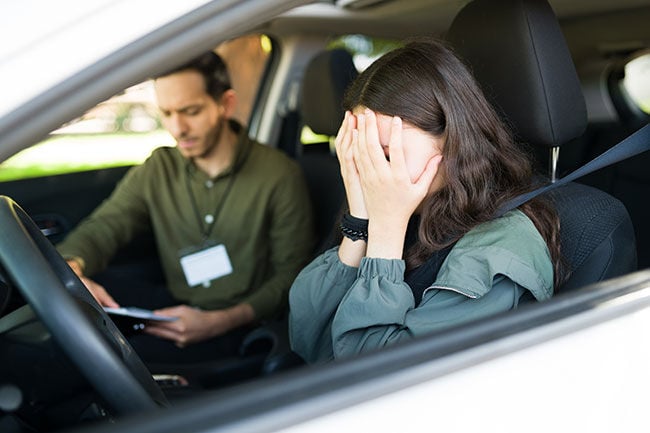
Most Commonly Missed Questions On the California Permit Practice Test
This post contains affiliate links to products and services. We may receive compensation when you click on links.
Worried about an upcoming permit test? You’re not alone. A large number of applicants fail this test on the first try, and while there are many reasons for those failures, the majority stumble on a handful of topics.
So, what are those topics and can you learn enough about them to nail the DMV permit test?

What is the California Permit Test?
The learner’s permit is the first step on the journey to getting a driver’s license in California.
There are 46 questions and 38 correct answers are needed for a pass. The questions are not released by the DMV, but you can take a number of practice tests to get an idea of what the test will look like and ensure you’re ready for it.
The test costs $33 and applicants are given three attempts to complete it within a 12-month period.
Most Commonly Missed Questions On the California Permit Practice Test
As the DMV doesn’t release questions from the test, there’s no telling what questions you will get. However, the topics usually remain the same and the questions tend to circulate. Some of the ones that applicants struggle with the most include:
1. Seatbelts must be used by…
Answer = By the driver and all passengers above a certain age/height
Seatbelts are something we take for granted, so much so that we often overlook simple regulations and requirements.
For instance, did you know that the California Vehicle Code Division 12 — Equipment of Vehicles prevents dealers from selling cars without adequate safety equipment (including airbags in cars manufactured after 1968), even if the vehicle is used and even if the dealer informs the buyer?
The question on the permit test relates to when seatbelts must be worn, with answers including variations of “everyone”, “only the driver/passenger” and “only driver, passenger, and children”.
The law states that seatbelts must be worn by the driver and passenger, as well as children who are 8+ or at least 4 feet 9 inches tall. If a child is less than 8 years old and below the height requirement, they must be secured in the back seat using a child passenger restraint system (which is a complicated way of saying “child car seat”).
2. What is the illegal blood alcohol concentration?
Answer: 0.8% for drivers over 21
You are required to know the legal limit for blood alcohol concentration (BAC) in your state. In California, it’s illegal for anyone over the age of 21 to drive with a BAC of 0.08% or more. This drops to just 0.01% for drivers under 21, as well as those on DUI probation.
This BAC limit applies across the United States, but the confusion lies with the age differences and Enhanced Penalty Limit. The latter refers to a BAC level that could lead to more severe fines and penalties. In California, it is fixed at 0.16%.
The permit test may include questions relating to the penalties for driving with a blood alcohol concentration at or above the legal limit. In this case, the answer is usually a little more straightforward, as it’s an offense that’s punishable by jail time and a fine.
You may even encounter a question about how to sober up, with options including “Black Coffee”, “Fresh Air”, and “Time”. The idea that a little fresh air and some strong black coffee can sober you up is largely a myth. Coffee can perk you up and may offset some of the effects of alcohol, but only time will rid the alcohol from your system and reduce your blood alcohol level to a safe and legal level.
3. This sign means…
Answer: Probably not what you think
The California permit test has a number of questions relating to signs. It’s a visual exam, so it’s important to do your research on state traffic signs and make sure you know what all of them mean. There’s no real easy fix for this and you can’t assume that the signs will be self-explanatory or instantly recognizable, even if you have spent some time on the road.
Just complete some practice tests or focus specifically on memorizing California road signs and their meanings.
4. What should you do if you have a blowout?
Answer: Slow to a stop
If your tire blows, you should slow to a gentle stop while tightly gripping the steering wheel. Don’t swerve off the road. Don’t hit the accelerator. Don’t turn quickly.
Once at the side of the road, you can call for help.
5. How far should you be from the vehicle in front?
Answer: 1 car length per 10mph or 3 seconds of space
The DMV test loves to quiz drivers on stopping distances as it’s something that many drivers struggle with. Tailgating is obviously not advised as you won’t have time to react if they suddenly slam the brakes.
The DMV usually recommends keeping 1 car length back for every 10mph. It also uses something known as the three-second rule, whereby you keep three seconds of space between you and the car in front.
6. How should you park on a hill?
Answer: So the car rolls into the curb
Obviously, the first thing you should do in this situation is engage the parking brake. Usually, though, the question addresses the direction of the wheels, and it’s something that may have never occurred to you.
You should park so that if the car rolls, it will roll into the curb. If you’re facing uphill, turn the wheels away from the curb; if you’re facing downhill, turn into the curb.
That way, if anything unexpected happens, you’re not sending a 3,000-pound hunk of metal careening down a busy road.
How to Prepare for the DMV Permit Test
Preparation is key with any exam, and the CA DMV permit test is no exception. Keep these things in mind to improve your chances of getting a passing mark:
Study, Study, Study
It’s probably not what you want to hear, but there are no quick fixes and the best way to learn (and eventually pass) is to study. Download the California Driver’s Handbook, read it, re-read it, and then read it again!
Take Permit Practice Tests
A practice test is a close representation of the real test. You won’t necessarily get those exact same questions, but if you’re acing the practice tests every time, there’s a high chance you’ll do the same with the real DMV test.
DMVCheatSheets has a bunch of practice tests and cheat sheets, including ones for the CA learner’s permit. You could also try a service like Aceable, which offers some Drivers Ed courses that aim to cover all bases.
A few other providers offer similar services but be wary of anything that claims to have the exact same questions provided by the DMV.
Don’t stop the tests just because you start getting everything right. One of the mistakes that students make is to complete a few practice tests, get top marks, and then stop. They assume they’re ready, even though they still have days or weeks before their exam. When they sit their exam, they encounter questions they’ve never seen before, at which point they don’t know what to do and fail.
It only takes a few mistakes to fail, so even if you’re nailing the tests, keep learning.
Check the Road Signs
Road signs are a sticking point for many learners. Some of the questions will seem obvious, others will become obvious once you learn the logic and laws behind them. But with road signs, the images can seem a little too abstract at times, and the only way to learn them is to see them, study them, and commit them to memory.
Get Some Help
If you have a parent, friend, or neighbor who drives, ask them to help you with your studies. You need someone to read the book and ask the questions, and if they drive themselves, they can provide some insights. It might not seem helpful at the time, and might even come across as patronizing, but a little story/lecture will likely be enough to commit that particular law to memory.
Prepare the Night Before
Keep the information fresh by studying the night before. Don’t let it interrupt your sleep though and don’t spend all night drinking and partying.
Get an early night, have a big breakfast in the morning, and make sure you’re fully rested.
FAQs
Is the California permit test hard?
It’s said that over half of all teens fail their first test, and that certainly makes it seem hard. But it’s only as difficult as you make it. Spend some time preparing and completing practice tests to ensure you’re ready.
How old do you need to be to apply for the CA permit test?
You must be at least 15 and a half to apply for this test.
How long is the permit test?
It will take around half an hour to complete.
What happens if I fail the test?
If you fail the first time around, don’t worry. It’s not the end of the world and you’re in good company. Just go back to the drawing board, complete some more practice tests, and apply again after the 7-day waiting period.
Summary: Commonly Missed Questions
Getting your driver’s license is exciting, but it’s also stressful and requires a lot of study and practice tests. So, keep the above questions in mind, prepare for them, and you can avoid falling into these common traps.
Related Content
- Best DMV Permit Practice Tests
- Can Deaf People Drive?
- How Many Questions Are on the California Permit Test?
- DMV Cheat Sheets vs Aceable Permit Practice Tests
- How to Pass Your California Driving Test First Time
- The Difference Between a California Driver’s License and a Driver’s Permit
- Most Commonly Missed Questions On the California Permit Practice Test


















